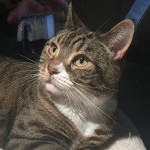News
Pet of the month – June 2019
by admin on June 6th, 2019
Category: Pet of the Month, Tags:
IBD is not a single disease but a group of chronic gastrointestinal disorders caused by an infiltration of inflammatory cells into the walls of a cat’s gastrointestinal tract. The infiltration of cells thickens the wall of the gastrointestinal tract and disrupts the intestine’s ability to function properly.
IBD occurs most often in middle-aged and older cats.
How is IBD diagnosed?
Symptoms of feline IBD are not specific. They may include vomiting, weight loss, diarrhea, lethargy and variable appetite.
The symptoms of IBD can vary depending on the area of the digestive tract affected.
A definitive diagnosis of feline IBD can only be made based on microscopical evaluation of tissue collected by means of an intestinal (or gastric) biopsy.
How is IBD treated?
The treatment of IBD usually involves a combination of change in diet and the use of various medications. There is no single best treatment for IBD in cats. Your veterinarian may need to try several different combinations to determine the best therapy for your cat.
Hypoallergenic diets are usually tried first. Corticosteroids like prednisolone may be used to reduce inflammation of the gut, and antiobiotics such as metronidazole are commonly used.
What does the future hold for a cat with IBD?
IBD is a chronic disease. Few cats are actually cured. Symptoms of IBD may wax and wane over time. IBD can often be controlled such that affected cats are healthy and comfortable. Vigilant monitoring by the veterinarian and owner is critical.
We are very pleased to report that Bob has responded well to dietary management and is currently not requiring additional medication. Luckily he is not adept at hunting and so we have no fear that he might upset the illness through illicit snacks!


